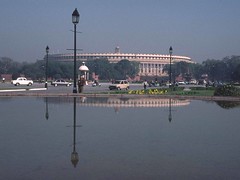
Image by williewonker via Flickr
Tue, Apr 27 10:46 AM
The UPA government faces the cut motion in the parliament.
Why is it so important?
Cut motion is a veto power given to the memeber of the Loks Sabha to oppose a demand in the financial bill discussed by the government. This can turn into an effective tool to test the strength of the government. If a cut motion is adopted by the House and the government does not have the numbers, it is obliged to resign.
Cut motion can be of following types:-
(i) Disapproval of policy cut: Amount of the demand be reduced to Re 1. A member giving notice of such a motion shall indicate in precise terms the particulars of the policy which he proposes to discuss. The discussion shall be confined to the specific point or points mentioned in the notice and it shall be open to members to advocate an alternative policy
(ii) Economic cut: Calling for cuts in a taxation proposal.The notice shall indicate briefly and precisely the particular matter on which discussion is sought to be raised and speeches shall be confined to the discussion as to how economy can be effected.
(iii) Token cut: A small cut of, say, Rs 100, meant to be a rebuke for the government
Tuesday's cut motion being moved to seek reduction in excise and customs duties on fuel prices.
However, the Speaker of the Lok Sabha enjoys the prerogative. Rule 211 authorises the Speaker to decide whether to admit a cut motion and Rule 210 empowers him to give 13 grounds for non-admissibility of a cut motion. The Speaker can reject a cut motion if it relates to more than one demand, it contains defamatory statements and it is a matter that does not concern the government.
Admissibility of cut motions
In order that notice of motion for reduction of the amount of demand may be admissible, it shall satisfy the following conditions, namely:-
(I) It shall relate to one demand only;
(ii) It shall be clearly expressed and shall not contain arguments, inferences, ironical expressions, imputations, epithets or defamatory statements;
(iii) It shall be confined to one specific matter which shall be stated in precise terms;
(iv) It shall not make suggestions for the amendment or repeal of existing laws;
(vi) It shall not refer to a matter which is not primarily the concern of the Government of India;
(vii) It shall not relate to expenditure charged on the Consolidated Fund of India;
(ix) It shall not raise a question of privilege;
(x) it shall not revive discussion on a matter which has been discussed in the same session and on which a decision has been taken;
Statute vs Convention:
Parliament convention: Cut motion never moved when demand for grants have been "guillotined"
What is Guillotine:
Demands for grants of ministries bunched together for assent of Lok Sabha
CPI leader Gurudas Dasgupta wants the Speaker to admit a cut motion despite a "guillotine". Dasgupta has cited Article 113 (2) of the Constitution which entitles the House to move a cut motion.
Source: Parliament of India
http://timesofindia.indiatimes.com/india/Cut-motion-against-government-defeated-SP-RJD-MPs-stay-away/articleshow/5864550.cmsNEW DELHI: The trial of strength for the government in the Lok Sabha proved to be a dampener with the House defeating the cut motion on petroleum prices by a big margin exposing huge divisions in the Opposition.
The cut motion moved by CPI leader Gurudas Dasgupta on failure to formulate proper policies on petroleum products was defeated by a margin of 88 votes when it received the support of 201 votes with 289 voting against it in a House of 543.
The government breezed through the Opposition challenge helped by a walk out by the Samajwadi Party and RJD together accounting for 25, and 21 BSP members voting with treasury benches in what was initially seen as a possible close trial of strength for the UPA-II coalition.
Another surprise voter for the government was Jharkhand chief minister Shibu Soren, who runs the state government on BJP's support.
The cut motion received the support of mainly BJP and its allies and Left Parties, while SP and RJD MPs walked out of the House before the vote, notwithstanding their attack on the government on the issue of price rise. Another cut motion of Leader of Opposition Sushma Swaraj was defeated 162-246 in a division.
Earlier in the day, the way for smooth passage of the demands was paved by BSP supremo and UP chief minister Mayawati who announced the party's support for the government to keep "communal forces" at bay from power in the centre. A similar reason was advanced by RJD and SP before walking out of the House, minutes ahead of the voting.
The BJP saw in it a government strategy of "misusing" CBI as a political instrument keeping the Damocle's sword on "vulnerable" opposition leaders. A senior BJP leader said the party has taken note of Soren supporting the government on the cut motion.
Leader of the House and finance minister Pranab Mukherjee later said the demands for grants were passed as expected. Parliamentary Affairs Minister P K Bansal wondered what the NDA and the Left Parties have achieved when against their total strength of 222, they got the support of only 201.
Prime Minister Manmohan Singh and UPA chairperson Sonia Gandhi were present during the 90-minute drama when almost the entire UPA was in full strength in the House. The demands for grants were taken up for voting after Speaker Meira Kumar applied guillotine on the discussion on demands for grants for over 60 ministries.


![Reblog this post [with Zemanta]](http://img.zemanta.com/reblog_e.png?x-id=ba0e4389-a901-439d-8eef-55a7cc4577ca)



No comments:
Post a Comment